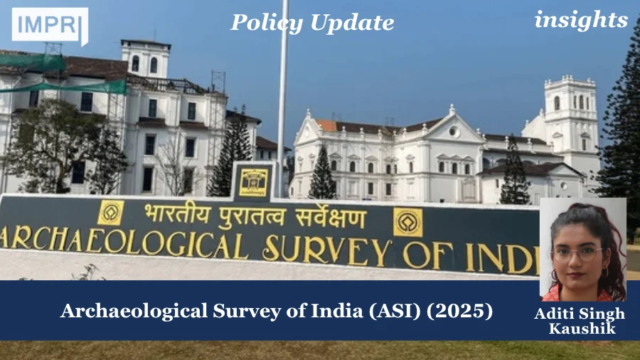Policy Update
Aditi Singh Kaushik
Background
The Archaeological Survey of India (ASI) was established in the year 1862. However, archaeological and historical pursuits in India date back to the year 1784, when the efforts of Sir William Jones led to the formation of the Asiatic Society in Calcutta. This endeavour led by Jones and other dilettantes like Tavernier, Finch and Bernier, Thevenot, Anquetil De Perron, to name a few, also culminated in the publication of a journal called Asiatic Researches started in 1788. Later, similar societies were established in Bombay (1804) and Madras (1818).
In the following years, a series of historical discoveries led by Jones helped compartmentalize Indian history into a chronological order. Some of these include – the identification of Chandragupta Maurya with the Greek name Sandrokottos, followed by the identification of Pataliputra at the confluence of the Ganga and Son rivers, and the decipherment of Gupta and Kutila script by Charles Wilkinson.
The antiquarian heritage of India has been brought to light for many years following the genesis of ASI, thanks to the efforts of individuals like Col. Colin Mackenzie, James Princep, Alexander Cunningham, Daya Ram Sahani, H.D Sankalia and K.K Muhammed to name a few.
Tracing the Quest for Preservation
In 1861, Alexander Cunningham, known as the Father of Indian Archaeology, put forward a proposal calling for the establishment of a government-run archaeological survey of India. In this document laid down before the British Government, Cunningham stressed the need for preservation of local monuments, not by the local administration, but by the Government of India, that “would be always held in judgment of the civilized world, primarily responsible for maintaining intact this great inheritance.”
This proposal was given due attention by Lord Canning, who sanctioned a scheme of survey in Northern India. It was defined as, “an accurate description illustrated by plans, measurements, drawing or photographs and by copies of inscriptions-of such remains as deserve notice, with the history of them so far as it may be traceable, and a record of the traditions that are retained regarding them.” After being appointed as the first Archaeological Surveyor of India in December 1861, Cunningham surveyed areas stretching from Gaya in the East to Indus in the Northwest, and from Kalsi in the North to Narmada in the South, between 1861 and 1865. These endeavours, however, came to a brief halt due to the abolition of the ASI in 1866 by Lord Lawrence due to a lack of funds and budget cuts.
The ASI was revived in 1871 as a separate department within the government, with Cunningham being appointed as Director General, who assumed his charge in February 1871. The ASI, which now functioned as a distinct department, was entrusted with the task of doing ‘a complete search over the whole country, and a systematic record and description of all architectural and other remains that are either remarkable for their antiquity, or their beauty or historical interest.’
The surveys of Cunningham led to several discoveries such as monolithic capitals, and other remains of Ashoka, specimens of Architecture of Gupta and post-Gupta period; great stupa of Bhahrut; identification of ancient cities: Sankisa, Sravasti and Kausambi. Amongst his most prominent excavations, stands the first systematic archaeological excavations at Sarnath. Cunningham’s excavation of the Stupa at Sarnath was one of the first attempts made towards scientific archaeological excavation in India.
Discovery of the Indus Valley Civilization
On September 20th, 1924, Sir John Marshall – Director General of the Archaeological Survey of India, published his story titled A FORGOTTEN AGE REVEALED in the Illustrated London News, announcing the discovery of the ancient Indus Valley Civilization to the world for the first time.

Marshall had been overseeing excavations by two Indian archaeologists – Daya Ram Sahani and R.D Banerji at two sites in Punjab and Sindh over the past three years, and later concluded with his colleagues that they had made major discoveries at the two ‘mysterious’ sites, which were later established to be Harappa and Mohenjodaro. The ASI announcement in 1924 astounded the archaeological world. The discovery ensured that Indian Archaeology had a seat ‘at the table of international inquiry into the origins of civilization.’
Some scholars opine that the discovery of the Indus Valley Civilization had a profound impact on Indian national identity. They observe that the effects of the discovery were so deeply rooted into the question of national pride that, following independence in 1947, when many famous Indus sites became part of the new nation of Pakistan, Indian archaeologists launched major research efforts ‘to discover comparable sites within the redefined boundaries of India’, which fortunately turned out to be quite productive. (Lewis, 2014)
Key Challenges within ASI in the 21st Century
- Budgetary Issues: The ASI is India’s key archaeological institution and one of the world’s largest archaeological agencies. Despite its stature and the fact that most states have archaeology departments, their budgets, and staff training vary greatly in response to limits set by state antiquities and monument legislations. On the other hand, while several universities across India have archaeology programs, only a handful are backed by institutional support.
- Crowded Urban Landscapes: Like places of historical heritage in other countries, several Indian sites and monuments (that are primary archaeological objects of research), are often either part of crowded urban landscape, or are still in active daily use. With lack of systematic supervision, these sites are being destroyed at a rapid rate. (Lewis, 2014)
- Stolen Prized Possessions: India, like other commonwealth countries around the world, is victim to its prized possessions being under the control of the English. Many primary documents relevant to historical archaeology in India reside in the British Archives today. The stolen artefacts have caused logistical challenges for the ASI, wherein the agency finds it difficult to maintain a centralised database for stolen artefacts.
Besides concerted efforts by local and national administration in India, scholars suggest that India needs a comprehensive, feasible national policy for the preservation of its cultural heritage – ‘one that encourages the development of a widely shared sense of stewardship of the past.’
References
About the Contributor
Aditi Singh Kaushik is a Research Intern at IMPRI. She holds a Master’s degree in Political Science from Banaras Hindu University. Her research interest lies in understanding the evolving roles of traditional and organic intellectuals in post-colonial countries, within a Gramscian framework.
Acknowledgement
The author sincerely thanks Ms. Aasthaba Jadeja and the IMPRI team for their valuable support.
Disclaimer
All views expressed in the article belong to the author and not necessarily to the organisation.



















